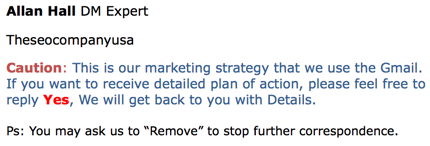Many of the operational goals of a commercial spammer aren’t related to email delivery at all, rather they revolve around optimizing ROI and minimizing costs. That’s even more true when the spammer isn’t trying to sell their own product, rather they’re making money by sending spam for other companies.
Most legitimate network providers pay at least lip service to not allowing abusive behaviour such as spam from their networks, so a spammer has to make a few choices about what infrastructure to use to optimize their costs.
They can be open about who they are and what they do, and host with a reputable network provider, and build out mailservers much as any legitimate ESP would do. But eventually they’ll get blacklisted by one of the more reputable reputation providers – leading to little of their mail being delivered, and increasing the pressure on their provider to terminate them. They social engineer their provider’s abuse desk, and drag their feet, and make small changes, but eventually they’ll need to move to another provider. Both the delaying tactics and the finally moving are expensive.
Or they can host with a network provider who doesn’t care about abuse from their network, and do the same thing. But they’ll still get blacklisted and, unlike on a more reputable network, they’re much less likely to get any benefit of the doubt from any reputation providers.
Every time they get blacklisted they can move to a new network provider. That’s easy to do if your infrastructure is virtual machine based and moving providers just involves buying a new hosting account. But as anyone who’s heard the phrase “ramping-up” knows mail from new network space is treated with suspicion, and as they’re continually moving their mail won’t reach the inbox much.
Preemptively spreading the sources of your spam across many different IP addresses on different providers, and sending spam out at low enough levels from each address that you’re less likely to be noticed is another approach. This is snowshoe spam and spam filters are getting better at detecting it.
What to do? In order to get mail delivered to the inbox the spammer needs to be sending from somewhere with a good reputation, ideally intermingled with lots of legitimate email, so that the false-positive induced pain of blocking the mailstream would be worse than their spam. That’s one reason a lot of spammers send through legitimate ESPs. They’re still having to jump from provider to provider as they’re terminated, but now they’re relying on the delivery reputation of the shared IP pools at each new ESP they jump to. But that still takes work to move between ESPs. And ESP policy enforcement people talk to each other…
As a spammer you want your mail to be sent from somewhere with good reputation, somewhere you can use many different accounts, so your spam is spread across many of them, flying below the radar. Ideally you wouldn’t have any documented connection to those accounts, so your activity won’t show up on any aggregated monitoring or reporting.
If nothing in the mail sent out identifies you there is nowhere for recipients to focus their ire. And if recipients can’t tell that the hundreds of pieces of spam in their inbox came from a single spammer, they’re much less likely to focus efforts on blocking that mail stream.
Over the past couple of years I’ve seen a new approach from dedicated B2B spammers, the sort who sell “buy and upload a list, blast out something advertising your company, track responses, send multiple mails over a series of weeks” services to salespeople. They’re the ones who tend to have glossy, legitimate websites, talking about “lead nurturing”, “automated drip campaigns” or “outreach automation”.
They have each of their customers sign up for gmail or google apps accounts, or use their existing google apps accounts, and then the spammer funnels the spam sent on behalf of that customer through that google account. There’s no obvious connection between the spammer and the google account so there’s no risk to the spammer. Google is fairly unresponsive to spam complaints, so as long as the volume sent by each customer isn’t spectacularly high it’s going to be well below Google automation’s threshold of notice.
Google do record where mail that’s injected into their infrastructure in this way comes from, in the Received headers. But the spammers run their sending infrastructure – list management, message composition, tracking and so on – on anonymous, throwaway virtual machines hosted on Amazon’s EC2 cloud, so there’s nothing in the email that leads back to the spammer.
And, for recipients, that’s a problem. Spam filters aren’t going to block this sort of mail, as they can’t easily tell it is this sort of mail. It’s coming from Google MTAs, just like a lot of legitimate mail does. In terms of sheer volume it’s dwarfed by botnet sourced mail or dubious B2B manufacturing spam out of Shenzhen. But, unlike most of that, it’s in your inbox, in front of your eyeballs and costing you time and focus. And that’s much more expensive than network infrastructure or mailbox storage space.
I’m not sure what, if anything, Google or Amazon can do about it at scale, but it’s something that’s going to need to be dealt with eventually.
Meanwhile, if you receive some marginally personalized mail from a sales rep, one attempting to look like 1:1 mail, look at the headers. If you see something like this …
Read More
